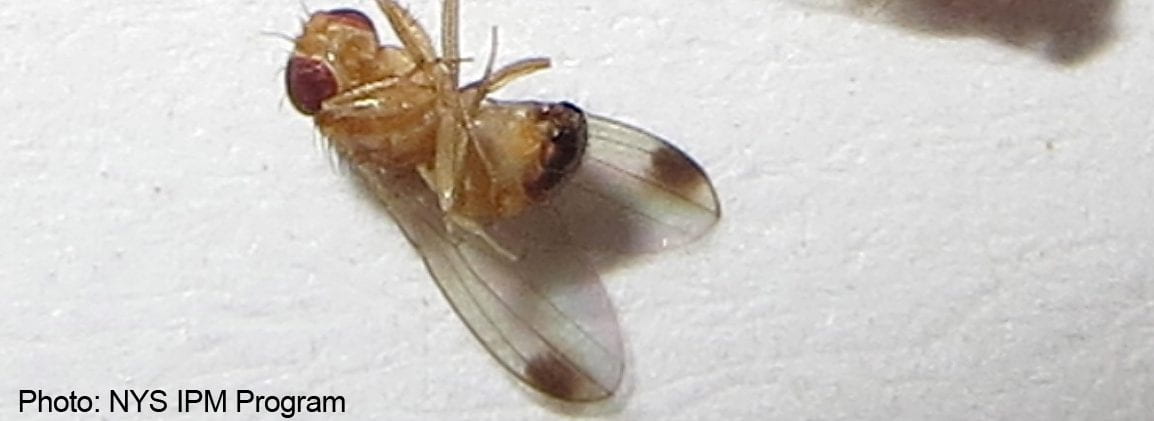The ability for the SWD population to explode as summer rolls on was demonstrated last week in several counties where I have research projects. Per trap, 5 to 125 SWD were caught in raspberry, blueberry, and tart cherry in mid-July. The totals for the two to four traps set in the orchards and fields were 14 to 250.
Use this summary as a wake up call! For the weeks ending on the date given:
7/11/2019, Schuyler County, blueberry, 4 traps, 22 SWD (11 males and 11 females)
7/11/2019, Schuyler County, raspberry, 4 traps, 108 SWD (64 males and 44 females)
7/22/2019, Herkimer County, blueberry, 4 traps, 30 SWD (12 males and 18 females)
7/22/2019, Wayne County, tart cherry, 2 traps, 14 SWD (1 male and 13 females)
7/22/2019, Wayne County, tart cherry, 2 traps, 24 SWD (4 males and 20 females)
7/22/2019, Wayne County, tart cherry, 2 traps, 57 SWD (9 males and 48 females)
7/22/2019, Wayne County, tart cherry, 2 traps, 85 SWD (19 males and 66 females)
7/22/2019, Wayne County, tart cherry, 2 traps, 250 SWD (60 males and 190 females)
7/23/2019, Wayne County, blueberry, 2 traps, 131 SWD (53 male and 78 females)
7/23/2019, Wayne County, blueberry, 4 traps, 29 SWD (14 male and 15 females)
In eight of the nine sites a spray program was in place to protect fruit. Fruit is ripe and being harvested – and it’s delicious! Fruit isn’t showing signs of infestation, which means insecticide programs can protect fruit from oviposition, even when SWD numbers are high. Download the Quick Reference Guide to SWD Insecticides at
- http://www.hort.cornell.edu/fruit/pdfs/swd/berry-insecticides.pdf for berries
- http://www.hort.cornell.edu/fruit/pdfs/swd/treefruit-grape-insecticides.pdf for stone fruit and grapes

Salt flotation – What these numbers also demonstrate is that trap catch numbers aren’t necessarily an indication of whether or not an insecticide program is working. A better indication is to sample fruit and run a salt flotation test. Two berry growers described their success last year using salt flotation to monitor infestations in blueberries, detailed on the blog, Use salt flotation to check for SWD. A simple method is described in Guidelines for Checking Fruit for SWD Larvae in the Field by Laura McDermott, which can be downloaded from Cornell Fruit Resources SWD Monitoring pages, fruit.cornell.edu/spottedwing/monitoring/. Large scale berry growers will routinely run salt flotation at each harvest, because blueberries, raspberries, and blackberries ripen and are harvested over several weeks. For crops that are harvested all at once, like tart cherry, salt flotation may not be as useful.
Refrigeration – The high populations of SWD, coupled with later ripening of many crops this year, make it even more important to immediately cool fruit after harvest. Cold storage temperatures close to 32°F can greatly inhibit and even kill SWD in fruit. Raspberries, blackberries, blueberries, and tart cherries will all tolerate cold storage temperatures between 32°F to 34°F.
Diversified fruit farms – Protect your crops from SWD, if you’re growing susceptible fruit – June strawberries, day-neutral strawberries, sweet cherries, tart cherries, raspberries, blackberries, elderberries, blueberries, peaches, nectarines, plums, prunes, and thin-skinned grapes. If you have a diversified fruit farm, SWD can spill over from one crop to the next as they are harvested and especially when cull fruit remains in the field. Renovate strawberry fields promptly.

Fruit becomes susceptible to SWD oviposition when it is ripening and is highly susceptible when it is ripe – raspberry, blackberry, blueberry, sweet cherry, tart cherry, elderberry. Fruit that is less susceptible will be attacked when it is at peak ripeness – peach, nectarine, plum, prune, strawberry, grapes. All fruit can serve as a resource for feeding and breeding when it is left for cull in the field. The good news is that, in degraded fruit, SWD doesn't compete all that well with other Drosophilas, like Drosophila melanogaster, our common vinegar fly, which often shows up in our kitchens in late summer or in the winery during press. SWD prefers nice ripe fruit — like we do!

